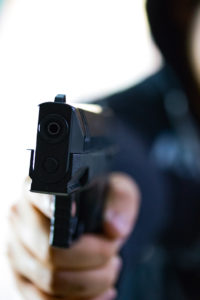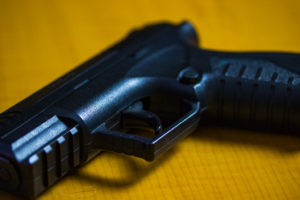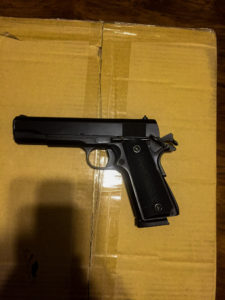Monday, Feb. 27, 2012 started just like any other day at Chardon High School in my hometown of Chardon, Ohio.
I was exhausted from spending the weekend at a church youth retreat. Around 7:15 a.m., I walked into my first class of the day with a kind of sluggish enthusiasm. I was excited to see my high school friends, but also dreading my classes. My classmates and I talked as we prepared for the rest of the day: a day just like any other of my high school career.
Suddenly, though, I heard screams coming from the hallway: the kind of screaming that grabs your attention and haunts your memories. Several first-year girls had sprinted into our classroom from the cafeteria down the hall with terror etched onto their faces. Within seconds of them entering our room, we were in lockdown. Our teacher ran to the door to lock it. Students huddled by the concrete wall farthest from the door. For several minutes, we just stood there staring at the door: the only thing separating us from the crisis happening down the hall.

I do not know how long we waited in that classroom. When I look back, it feels like an eternity. Mass confusion and barely contained panic spread around the classroom like a virus. Students were restless. I remember feeling the inability to sit down and the need to keep my eyes on the door as much as possible.
From inside our classroom, we had no way of knowing the specifics of the massacre happening down the hall. Many students turned to Twitter for answers. Bad service in our classroom meant that we would get unverified snapshots of information as service faded in and out.
On our phones, we were bombarded with students asking for prayers, crazy rumors about multiple shooters and mass casualties, and texts from people we loved and cared about asking where we were and if we were going to be okay. Occasionally, a student would read a tweet to the class, and no one knew how to react to the information. One student would laugh out loud and make jokes, while several others went silent and stared at the walls.
For a long time, no one knew if the shooting was still going on. We didn’t know how many had died. We didn’t know if we were safe or if we would see our families again. I stared at the door, asking myself a question no 16-year-old should have to answer: “Am I willing to die to save my friends?”
After a while, a loud knock on our door sent a thrill through my whole body. There was yelling. Our teacher opened the door to a group of SWAT team members, who were carrying some of the biggest rifles I had ever seen in my life. We walked past them on our way out of the room. I remember looking up at them and feeling so small and fragile.
We were taken through the silent halls of our high school, out a backdoor and to an elementary school across the street to be picked up by our parents. As my dad drove my brother and me home, we sat silently and listened to the pundits on the radio sharing the news of what had happened. When I finally got home, I ran upstairs and into my mother’s arms; I have never seen her cry harder in my life, and it broke my heart.
On the morning of Feb. 27, 2012, a male student wearing a t-shirt with the word “Killer” on the front opened fire on students in my high school’s cafeteria. His murderous rampage would take the lives of three of my classmates and forever change the lives of every person in the Chardon community.

Despite the overwhelming outpouring of support and love from all over the world, suicide attempts in the community increased as students and community members attempted to deal with feelings of intense grief, flare-ups of post-traumatic stress disorder, and the sudden feeling that nowhere in the world is safe. For me, the shooting fundamentally changed the way I saw and heard things. I had a hard time hearing “I’m going to shoot myself in the head” or other sarcastic comments people say when they’re bored.
Even something as simple as student section chants had a changed meaning for me. Before the shooting, the basketball student section used to scream, “SHOTS, SHOTS, SHOTS, SHOTS, SHOTS, SHOTS, EVERYBODY!” from the chorus of the LMFAO song whenever a three-point shot was made. I heard that chant much differently after the shooting.
The aftershocks weren’t always so harmless. My senior year, there were several times during first period when I was convinced I heard gunshots coming from the hallway. A quick scan around the room confirmed that I was the only person who had heard them, which did nothing to ease the panic I felt in that moment. After the Colorado movie theater shooting, I had a minor panic attack at a showing of the movie “Les Misérables,” because I thought that the theater would be attacked. To this day, I have an irrational fear of drive-by shootings from cars driving past me or stopped next to me on the street.
Sadly, these kinds of thoughts and feelings have become a reality of life for some of my friends who experienced that Monday with me. I am sure that these memories and feelings will be with us in some way for as long as we live.
So, what can be taken away from my story? What is the lesson to be learned? The first is that there is a serious problem in the way we view mental illness in this country. Be the friend that encourages those who you know are struggling with mental illness to seek counseling. Forty million adults experience an anxiety disorder in the United States, yet only 37 percent of those pursue treatment.
I believed that I was too strong for counseling, or that my problems were not important enough to take a spot on the schedule. If you are struggling with mental illness, I am here to tell you that it is okay, that you are not alone and that there truly are people out there who will help you.
My second bit of advice is to give your time to something greater than yourself. After the shooting, a group that makes blankets for students who have gone through trauma gave one to each student at the high school. My high school set up our own branch of this group after this gesture of kindness. Through this group, I was able to take a trip to Newtown after their school shooting and hand-deliver blankets to them. It was one of the most rewarding experiences of my life.
The blankets were not the only example of the outpouring of support Chardon received in the months after the shooting, and each of these things helped me remember that there are people in the world beyond our walls that care about what happens to us. There is nothing more valuable in this life than your time and attention, and using those resources to help those in need makes the world a better place.
Finally, in the six years since this experience, I have heard many people say, “Live every day as if it were your last, because it absolutely could be.” There is some truth to that, and what I went through shows that life is fragile and can be ripped from you without warning.
But I have also found that this is an unrealistic standard to hold myself to. To live is all that we know, and I find myself taking the fact that I am alive for granted every single day. What I encourage instead is to do your best to be unembarrassed. Follow your dreams unapologetically and support those who are doing the same. Try not to settle for those people in your life who make you feel uncomfortable for being who you are. And more than anything else, never miss a chance to tell those you care about that you love them, as you never know when that chance will be your last.

